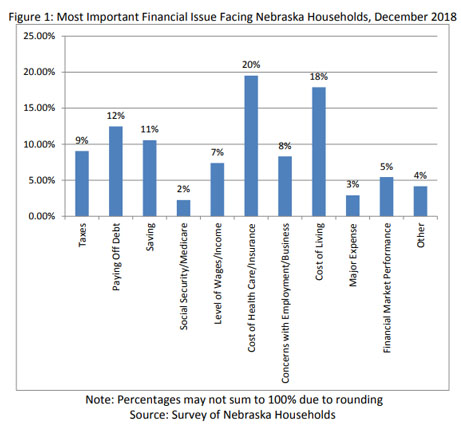Consumer confidence dropped in Nebraska during December, according to the latest monthly surveys from the Bureau of Business Research at the University of Nebraska-Lincoln.
Responses to the December Survey of Nebraska Households indicate that consumer confidence stood at 99.1 in December, just below the neutral level of 100.0 and well below the November reading of 106.4. Nebraska business confidence, by contrast, remained strong during December.
Responses to the Survey of Nebraska Business indicate that business confidence stood at 109.9. This is well above the neutral value of 100 and slightly up from a reading of 107.2 in November.
 Most important financial issue facing Nebraska households.
Most important financial issue facing Nebraska households.
“Strong business confidence suggests a positive outlook for the Nebraska economy,” said Eric Thompson, an economist who serves as Bureau director. “However, it will be important to monitor whether consumer confidence improves in the coming months.”
The cost of living was a major concern for Nebraka households. One half of Nebraska households expressed concerns about the cost of health care, taxes, major expenses (such as home repairs) or the general cost of living. “Households were especially concerned about the cost of utilities, insurance, food and education,” according to Thompson. Businesses were primarily concerned about customer demand, particularly businesses in agriculture and the healthcare industry. Healthcare businesses felt that insurance reimbursement rates and rising patient co-pays and deductibles were hurting customer demand.
The surveys are sent each month to 500 randomly selected Nebraska businesses and households. During December, 141 businesses responded to the Survey of Nebraska Business, for a response rate of 28 percent. There were 129 responses to the Survey of Nebraska Households, for a response rate of 26 percent.
Published: January 4, 2019